Human Spaceflights
![]()
International Flight No. 164STS-60Discovery (18)60th Space Shuttle missionUSA |
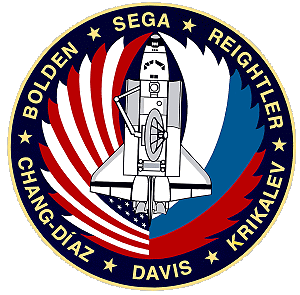 |
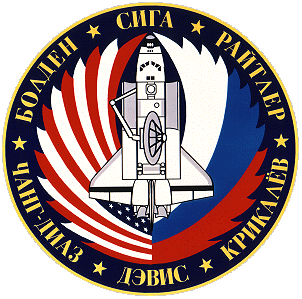 |
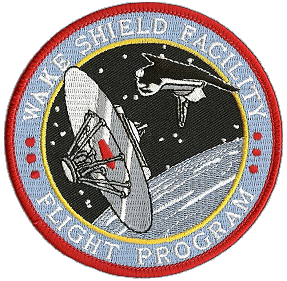 |
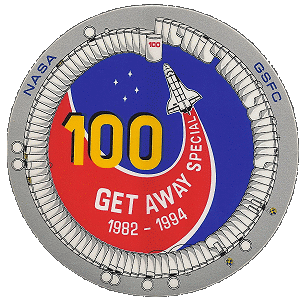 |
|
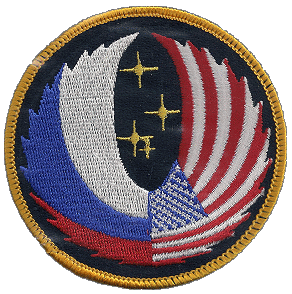 |
||
![]()
Launch, orbit and landing data
walkout photo |
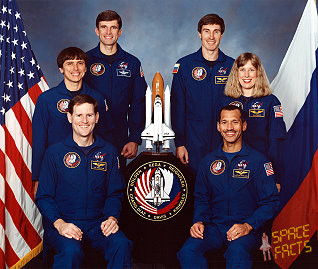 |
||||||||||||||||||||||||||||
alternative crew photo |
|||||||||||||||||||||||||||||
alternative crew photo |
|||||||||||||||||||||||||||||
alternative crew photo |
Crew
| No. | Surname | Given names | Position | Flight No. | Duration | Orbits | |
| 1 | Bolden | Charles Frank, Jr. "Charlie" | CDR | 4 | 8d 07h 09m 22s | 130 | |
| 2 | Reightler | Kenneth Stanley, Jr. | PLT, IV-1, EV-3 | 2 | 8d 07h 09m 22s | 130 | |
| 3 | Davis | Nancy Jan | MS-1, EV-2, RMS | 2 | 8d 07h 09m 22s | 130 | |
| 4 | Sega | Ronald Michael | MS-2, FE | 1 | 8d 07h 09m 22s | 130 | |
| 5 | Chang-Diaz | Franklin Ramon | MS-3, PLC, EV-1 | 4 | 8d 07h 09m 22s | 130 | |
| 6 | Krikalyov | Sergei Konstantinovich | MS-4 | 3 | 8d 07h 09m 22s | 130 |
Crew seating arrangement
|
 |
|
||||||||||||||||||||||||||||
Backup Crew
|
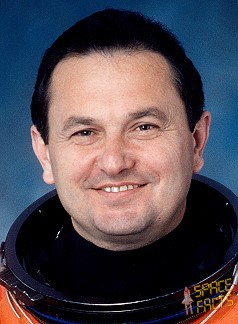 |
||||||||||
Hardware
| Orbiter : | OV-103 (18.) |
| SSME (1 / 2 / 3): | 2012 (15.) / 2034 (4.) / 2032 (2.) |
| SRB: | BI-062 / RSRM 35 |
| ET: | ET-61 (LWT-54) |
| OMS Pod: | Left Pod 01 (21.) / Right Pod 03 (19.) |
| FWD RCS Pod: | FRC 3 (18.) |
| RMS: | 201 (12.) |
| EMU: | EMU No. 2025 (PLSS No. 1010) / EMU No. 2027 (PLSS No. 1015) |
Flight
|
Launch from Cape Canaveral (KSC) and
landing on Cape Canaveral (KSC), Runway 15. STS-60 was highlighted by the participation of a Russian cosmonaut serving as a crew member aboard Space Shuttle Discovery. It was the first time since ASTP that a Russian cosmonaut was onboard of an U.S. spacecraft. STS-60 was the first mission of the US/Russian Shuttle-MIR Program. A new era of human space flight cooperative efforts between the United States and Russia began with the flight of Russian cosmonaut Sergei Krikalyov as a member of the STS-60 crew. His flight aboard the Shuttle was the beginning of a three-phased program. Phase one entailed up to 10 Space Shuttle-MIR missions including rendezvous, docking and crew transfers between 1995 and 1997. Phase two was the joint development of the core international space station program. Phase three was the expansion of the space station to include all of the international partners. The STS-60 mission was scheduled to see the first flight of the Wake Shield Facility (WSF), a 12-foot (3.66 meters) diameter, stainless steel disk which should be deployed and retrieved using the Shuttle mechanical arm. While it should fly free of the Space Shuttle, WSF should generate an "ultra-vacuum" environment in space within which to grow thin semiconductor films for next-generation advanced electronics. The commercial applications for these new semiconductors include digital cellular telephones, high-speed transistors and processors, fiber optics, opto-electronics and high-definition television. The commercially developed SPACEHAB facility made its second flight aboard the Space Shuttle during the STS-60 mission. Located in the forward end of the Shuttle cargo bay, it was accessed from the orbiter middeck through a tunnel and provided an 1100-cubic-feet (31.15 cubic meters) of working and storage space. Experiments being carried in SPACEHAB-2 involved materials processing, biotechnology and hardware and technology development payloads. Shortly after reaching orbit, the STS-60 crew began checking Discovery's systems and activating the commercially developed SPACEHAB laboratory module and several of its experiments. The crew also activated one group of the payload bay Getaway Special experiments. The Wake Shield Facility (WSF) was a 12-foot (3.66 meters) diameter, stainless steel disk designed to generate an "ultravacuum" environment in space within which to grow thin semiconductor films for next-generation advanced electronics. This mission represented the first time, internationally, in which the vacuum of space should be used to process thin film materials. The principle objectives of the WSF-1 mission included the characterization of the "ultra-vacuum" environment generated by the WSF in low Earth orbit (LEO) space, and the flow field around the WSF, and Molecular Beam Epitaxy (MBE) - growth of a thin film of the compound Gallium Arsenide (GaAs). The WSF consisted of the Shuttle Cross Bay Carrier (SCBC) and the Free Flyer. The SCBC remains in the Shuttle and has a latch system which holds the Free Flyer to the Carrier. The Shuttle "arm" or Remote Manipulator System (RMS) is attached to the Free Flyer for deployment and free flight in space. The SCBC has an extended-range, stand-alone RF communications system that lets the WSF seem like an attached payload to the Shuttle's systems, even when the Free Flyer is following ahead the Shuttle at its stationkeeping distance of 40 nautical miles. The Free Flyer was a fully-equipped spacecraft on its own, with cold gas propulsion for separation from the Shuttle and a momentum bias attitude control system (ACS). Forty-five kilowatt-hours of energy, stored in silver-zinc batteries, were available to power the thin film growth cells, substrate heaters, process controllers, and a sophisticated array of characterization devices. Weighing approximately 9,000 lbs. (4,082 kg) (the Free Flyer alone was 4,000 lbs. = 1,814 kg), the WSF occupied one quarter of the Shuttle payload bay. Controlling electronics, attitude control system, batteries and solar panels, and MBE process control equipment were on the back (wake side) of the WSF, while the avionics and support equipment were located on the front (ram side). The Wake Shield Facility deployment operation was canceled on Saturday. This delay was the result of several factors, including radio interference and an inability to read the Wake Shield's status lights when the orbiter's payload bay is in full sunlight. Deployment originally was scheduled for 10 am CST, but after grappling the free-flyer and lifting it out of the cargo bay and into the pre-deploy position, crew members and investigators on the ground were unable to tell whether power and transmitter status lights were giving the proper indications. After determining that the problem was not a systems failure, but difficulty in reading the status lights, the crew and flight controllers prepared for another release attempt. Interference between the radio transmitter on the Wake Shield Facility and the receiver on its payload bay carrier resulted in the one-day wave-off. Wake Shield deployment was also cancelled on Sunday, February 06, 1994 during its orbit 53 opportunity at 12:25 pm WSF and flight controllers worked problems with the Pitch and Roll sensors on WSF's Attitude, Direction and Control system. Astronaut Jan Davis moved the wrist joint on the Remote Manipulator System (RMS) arm to try to point WSF's Horizon Sensor into the Sun in an attempt to warm up the sensor's electronics package. The last deploy opportunity for Sunday was a 50-minute window beginning at 07:23 UTC on orbit 54 and WSF was not ready for deployment. It was left mounted on the RMS during the crew sleep period while ground controllers considered their options. On its perch at the end of the RMS overnight, WSF was able to grow 2 Gallium Arsenide (GaAs) thin films. The next deploy opportunity on February 07, 1994 would have been orbit 67 but payload controllers and flight controllers determined that there would be insufficient time to safely develop contingency procedures in the event that WSF was unable to maintain stable attitude control without the use of its Horizon Sensor. It was decided that for the remainder of the mission, all WSF operations would take place at the end of the RMS and there would be no WSF free-flying operations on the mission. The SPACEHAB Space Research Laboratory was located in the forward end of the Shuttle orbiter cargo bay and was accessed from the orbiter middeck through a tunnel adapter connected to the airlock. It weighed 10,584 pounds (4,800 kg), is 9.2 feet (2.80 meters) long, 11.2 feet (3.41 meters) high and 13.5 feet (4.12 meters) in diameter. It increased pressurized experiment space in the Shuttle orbiter by 1100 cubic feet (31.15 cubic meters), quadrupling the working and storage volume available. Environmental control of the laboratory's interior maintains ambient temperatures between 65 and 80 degrees Fahrenheit (18.1 and 26.7 degrees Celsius). The laboratory had a total payload capacity of 3,000 pounds (1,360 kg) based on operational constraints and, in addition to facilitating crew access, provided the experiments with standard services, such as power, temperature control and command/data functions. Other services, such as late access/early retrieval and vacuum venting also were available. The laboratory could also accommodate up to two SPACEHAB racks, either of which could be a "double-rack" or "single-rack" configuration. A "double-rack" provided a maximum capacity of 1250 pounds (567 kg) and 45 cubic feet (1.27 cubic meter) of volume, whereas a "single-rack" provided half of that capacity. The "double- rack" was similar in size and design to the racks planned for use in the space station. The second voyage of the SPACEHAB Space Research Laboratory contained 12 payloads conducted under the CMAM contract. Like SPACEHAB-1 (STS-57), SPACEHAB-2 payloads represented a wide range of space experimentation including 9 commercial development of space experiments in materials processing and biotechnology. SPACEHAB-2 carried seven biotechnology experiments. These experiments ranged from improving drugs to feeding plants, from splitting cells to studying the immune system disorders. Two materials processing experiments used furnaces to study sintering of metals and the growth of crystals by vapor transport. The third concentration of experiments was in supporting hardware, with two payloads designed to obtain data on the low-gravity environment of this SPACEHAB flight, to support data analysis of the other investigations, and to further characterize SPACEHAB as a carrier for microgravity experiments. On STS-60, the SPACEHAB-2 Equipment for Controlled Liquid Phase Sintering Experiments (ECLiPSE) investigated the Liquid Phase Sintering (LPS) of metallic systems. Sintering is a well-characterized process by which metallic powders are consolidated into a metal at temperatures only 50% of that required to melt all of the constituent phases. In LPS, a liquid coexists with the solid, which can produce sedimentation, thus producing materials that lack homogeneity and dimensional stability. To control sedimentation effects, manufacturers limit the volume of the liquid. The ECLiPSE experiment examined metallic composites at or above the liquid volume limit to more fully understand the processes taking place and to produce materials that are dimensionally stable and homogeneous in the absence of gravity. The ECLiPSE project was focused on composites of hard metals in a tough metal matrix. This composite had the excellent wearing properties of the hard material and the strength of the tough material. Applications of such a composite include stronger, lighter, more durable metals for bearings, cutting tools, electrical brushes, contact points and irregularly shaped mechanical parts for high stress environments. The Space Experiment Facility (SEF) was a space flight furnace system managed by the Consortium for Materials Development in Space (CMDS) based at the University of Alabama in Huntsville (UAH). The SEF was manufactured by Boeing Commercial Space Development Company, Seattle, WA, and was similar to Boeing's Crystals by Vapor Transport Experiment (CVTE) furnace which flew in October 1992 on STS-52. The initial objective of the SEF project was to provide a vapor transport crystal growth furnace for use by the CCDSs. The SEF system had the capability to carry one, two or three separate furnaces at one time and had room for two samples in each furnace, for a total of up to six samples. The CVTE was designed as a middeck facility while the SEF was adapted for flight in the SPACEHAB Space Research Laboratory and was mounted in a SPACEHAB single rack. This is the first flight of the SEF. The objective of the ASTROCULTURE (ASC) series of flight experiments was to validate the performance of plant growth technologies in the microgravity environment of space. Each of the flight experiments involved the incremental addition of important subsystems required to provide the necessary environmental control for plant growth. The flight hardware was based on commercially available components, thereby significantly reducing the cost of the hardware. The information from these flight experiments will become the basis for developing large scale plant growing units required in a life support system. In addition, these technologies will also have extensive uses on Earth, such as improved dehumidification/humidification units, water-efficient irrigation systems, and energy-efficient lighting systems for plant growth. The ASC-1 flight experiment, conducted during the USML-1 mission on STS-50, evaluated the WCSAR concept for providing water and nutrients to plants. The ASC-2 flight experiment, conducted during the SPACEHAB-01 mission on STS-57, provided additional data on the water and nutrient delivery concept, plus an evaluation of the light emitting diode (LED) based plant lighting concept. Results from both these flight experiments indicate that all the goals were achieved and confirmed the validity of these concepts for use in space-based plant growing unit. The ASTROCULTURE (ASC-3) flight experiment included in the SPACEHAB-2 mission was designed to validate a WCSAR developed concept for controlling temperature and humidity in a closed air loop of the plant growth chamber. This unit was capable of both humidifying and dehumidifying the air and did not require a gas/liquid separator for recovery of the condensed water as do all other systems now being used for dehumidification in space. This condensed water could be used as a source of cooking and drinking water. Demonstration of the successful performance in space of this humidity and temperature control technology will represent a major advance in our ability to provide superior environmental control for plant growth in an inexpensive and reliable space flight package. The Penn State Biomodule (PSB) payload tested the hypothesis that exposure to near zero gravity (microgravity) can alter microbial gene expression in commercially useful ways. The microbes scheduled to be tested aboard STS-60, Bacillus thuringiensis var. tenebrionis, are known to be specifically effective against the Colorado potato beetle. They were carried in the Penn State Biomodule which was being used for the first time aboard the Shuttle. The biomodule was a computercontrolled, fluid-transfer, mixing device developed by the Center for Cell Research. It was flight tested and developed aboard the Consort sounding rocket series. The BioServe Pilot Laboratory (BPL) will play an important role in providing the commercial and scientific communities affordable access to space for material and life sciences research. The main focus of the project was to provide a "first step" opportunity to companies interested in exploring materials processing and life science experiments in space. The notion ahead the project was to allow industry a mechanism for entry level "proof of concept" flights. Thus, the BPL was a crucial screening device for more complex, targeted space research and development activities. One investigation examined Rhizobium trifolii behavior in microgravity. Rhizobia are special bacteria that form a symbiotic relationship with certain plants. The bacteria infect the plants early in seedling development to form nodules on the plant roots. The bacteria in these nodules derive nutritional support from the plant while in turn providing the plant with nitrogen fixed from the air. Plants that form such relationships with rhizobia are called legumes and include alfalfa, clover and soybean. Such plants do not require synthetic fertilizers to grow. In contrast, many important crop plants such as wheat and corn are dependent on synthetic fertilizers since they do not form symbiotic relationships with rhizobia. The Commercial Generic Bioprocessing Apparatus (CGBA) supported 32 separate commercial investigations, which can be classified in three application areas: biomedical testing and drug development, controlled ecological life support system (CELSS) development and agricultural development and manufacture of biological-based materials. The CGBA consisted of 432 Fluids Processing Apparatuses (FPAs) packaged in 54 Group Activation Packs (GAPs). The goal of IMMUNE-1 was to reduce or prevent the changes seen in the immune system of rats after space flight. The experiment provided a new therapy to treat the effects of space flight on the human immune system, as well as on physiological systems affected by the immune system. Each of the two CAEMs in the Shuttle's middeck area held six rats. Six of the rats were treated preflight with a prescribed dosage of a compound similar to the commercially available recombinant Interleukin-2, which is known to stimulate the immune system. The rats lived in an environment similar to that of the astronauts in terms of launch stress, length of exposure to microgravity, and the forces of Shuttle re-entry and recovery. These conditions are known to result in a suppression of the immune system similar to "shipping fever" in cattle. The utility of PEG-IL-2 in preventing spaceflight-induced effects on the immune system may lead to its use as a therapeutic treatment for shipping fever in animals on Earth. Organic Separation Experiment (ORSEP) offered the commercial and scientific communities the opportunity to separate cells and particles based on their surface properties using a process known as counter current phase partitioning. Such separations cannot be carried to equilibrium on Earth because sedimentation influences the separation before partitioning equilibrium can be established. It was hoped that equilibrium separations will produce subpopulations with nearly identical surface properties rather than with some contamination of surface and density that is presently the case with Earth-based users. The potential commercial value of separations included the opportunity to identify subpopulations, to study the purified samples and to culture cell subpopulations for cell product. It was a multi-sample, multi-step, fully automated device that separated non-biological particles, as well as biological cells, particles, macromolecular assemblies and organelles in low gravity via partitioning in liquid polymer two-phase systems. Commercial Protein Crystal Growth: The objective of space-based protein crystal growth experiments on STS-60 SPACEHAB-2 was to produce large, well-ordered crystals of various proteins. These crystals are to be used in ground-based studies to determine the three-dimensional structures of the proteins. These experiments also continue to investigate how to control and optimize protein crystal growth in order to reduce uncertainties or risks associated with using this space-based process as a vital and enabling technology for many critical areas. The SPACEHAB-01 protein crystal growth experiments were extremely successful. Three of the seven proteins flown produced superior data when compared to the very best crystals ever obtained by Earth-grown methods using any other method of crystallization. Three-Dimensional Microgravity Accelerometer (3-DMA): The acceleration measurements system helped chart the effects of deviations of zero gravity on the experiments conducted in space. The microgravity environment inside the SPACEHAB Space Research Laboratory was measured in three dimensions by the 3-DMA at different locations, allowing researchers to review experiment results against deviations from zero gravity. This information was used to determine the degree of microgravity achieved inside the SPACEHAB Space Research Laboratory. 3-DMA measured disturbances caused by operating various experiments in SPACEHAB and the residual microgravity resulting from orbiter rotational motions and by the resistance of extreme upper atmosphere fringes. The 3-DMA experiment was successful on the SPACEHAB-01 STS-57 flight. The 3-DMA hardware consisted of four accelerometer assemblies to be located in different parts of the SPACEHAB Space Research Laboratory. The accelerometer package was comprised of three remotely located standard three-dimensional systems and three new invertible accelerometers in the central unit. The signal processing system and the new, unique invertible feature permit measurements of absolute microgravity and low-level, quasi-steady, residual accelerations. Those extremely low frequency disturbances are particularly detrimental to space processes such as crystal growth and have proven difficult to measure in the past. The accelerometers provide the acceleration data to a central control unit located in a single locker. The data were recorded in flight on three two-gigabyte magnetic hard drive devices. The Space Acceleration Measurement System (SAMS) was designed to measure and record low-level accelerations during experiment operations. The signals from these sensors were amplified, filtered and converted to digital data before being stored on optical disks and sent via downlink to the ground control center. SAMS has flown successfully on seven previous Shuttle flights and acquired nearly 15 gigabytes of data which represents 50 days of operation. Approximately two gigabytes of data were acquired on the SPACEHAB-2 mission. Three sensors were flown. One sensor measured the disturbances near an Environmental Control Support System. Another sensor will be located on the support structure of the SPACEHAB Space Research Laboratory. The third sensor was attached to a locker door to determine the level of disturbances experienced by experiments in the locker and nearby. Data from all three sensors were used to further characterize the SPACEHAB Space Research Laboratory microgravity environment. SAMS data were compared with data from the Three-Dimensional Microgravity Accelerometer (3-DMA). Sergei Krikalyov had been operating the SAMS experiment. The flight of the Stirling Orbiter Refrigerator/Freezer (SOR/F) on SPACEHAB-2 was a demonstration to obtain necessary information and characterization about the operation of Stirling refrigerator/freezer technology in microgravity. If proven successful, this technology will be targeted to replace the current vapor compression systems, which historically have had marginal reliability and lower theoretical efficiencies. The Stirling system in the SOR/F used environmentally benign helium as a working fluid, had an easily variable capacity, a quick chill capacity, long life gas bearings, and a motor hermetically sealed within the fluid loop, thus avoiding leakage. The Sample Return Experiment was on top of the Spacehab Module poised to capture intact cosmic dust particles as they come in contact with the 160 capture cells. The capture cells consisted of transparent silica aerogel with a density of 0.02/ g/cm³. Silica aerogel is the lowest density known solid material and has extremely fine structure, about 50A. Cosmic dust particles come from other planetary bodies, remnants of the formation of our solar system, or materials of other stellar systems. Capturing them allows detailed laboratory studies needed to gain understanding of their composition, type of cosmic processing and even the age. The information will contribute to answering the questions pertaining to the origin and development of our solar system and life itself. Along with the cosmic dust, space debris and other hypervelocity materials will be captured to provide detailed tracing of the sources of these other particles as well. Orbital Debris Radar Calibration Sheres (ODERACS) deployed six spheres of three different sizes from the orbiter payload bay. The spheres range in size from two to six inches in diameter (five to 15.2 centimeters). The spheres were observed, tracked, and recorded by ground-based radars and optical telescopes. ODERACS enabled end-to-end calibration of the radar facilities and data analysis systems. This calibration is particularly geared toward the small debris size range. Additionally, ODERACS enabled the correlation of controlled empirical optical and radar debris signatures to the spheres which have physical dimensions, compositions, albedos, and electromagnetic scattering properties. On STS-53 the same experiment failed. The crew successfully deployed the small German built Bremsat satellite on February 09, 1994. It was developed by the Bremen University and build by company OHB-System and performed environment observations. Students in the U.S. and Russia had a chance to speak via amateur radio with astronauts aboard the Space Shuttle Discovery during STS-60. Ground-based amateur radio operators ("hams") were able to contact the Shuttle through automated computer-to-computer amateur (packet) radio link. There also were be voice contacts with the general ham community. Shuttle commander Charles Bolden and mission specialists Ronald Sega and Sergei Krikalyov (call sign U5MIR) talked with students in 5 schools in the U.S. and Russia using "ham radio". The radio contacts were part of the SAREX (Shuttle Amateur Radio EXperiment) project. The objectives of the Auroral Photography Experiment-B (APE-B) were to obtain spectral images of orbiter thruster emissions, Shuttle glow, air glow and auroral glow. This was accomplished by photographing these phenomena with the on-board CCTV cameras and recording the information on two video cassettes. Still photos were taken with a spectrometer assembly consisting of a 35 mm camera, intensifier assembly, 55 mm lens, clamp and spectrometer section. The experiment was operated by the flight crew at pre-determined times throughout the mission. |
Photos / Graphics
 |
 |
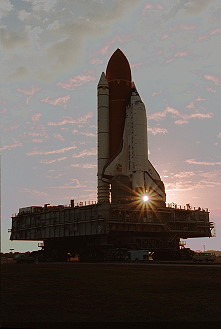 |
 |
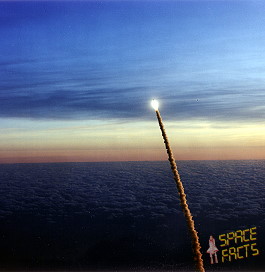 |
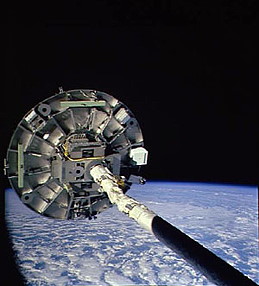 |
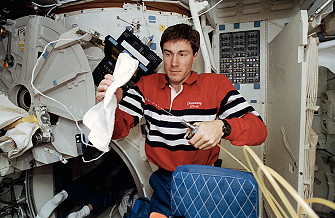 |
 |
 |
 |
 |
 |
more Earth observation photos |
|
| © |  |
Last update on June 19, 2023.  |
 |